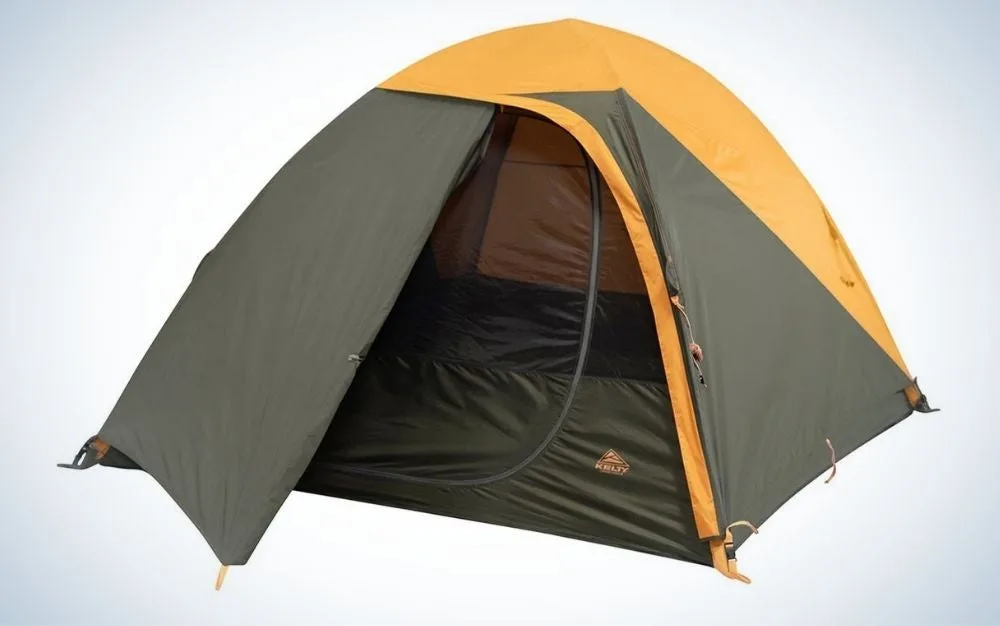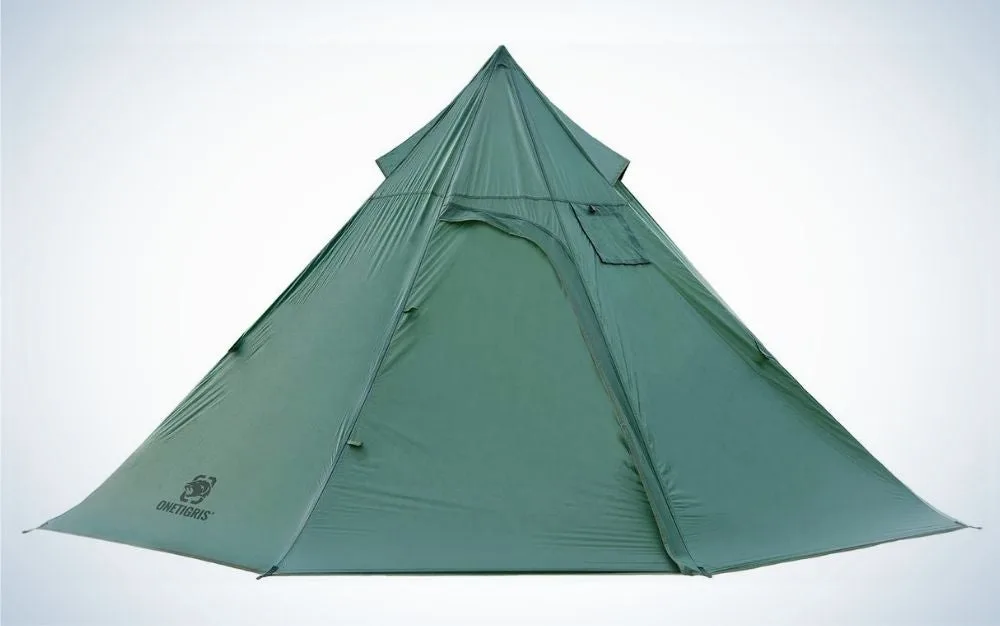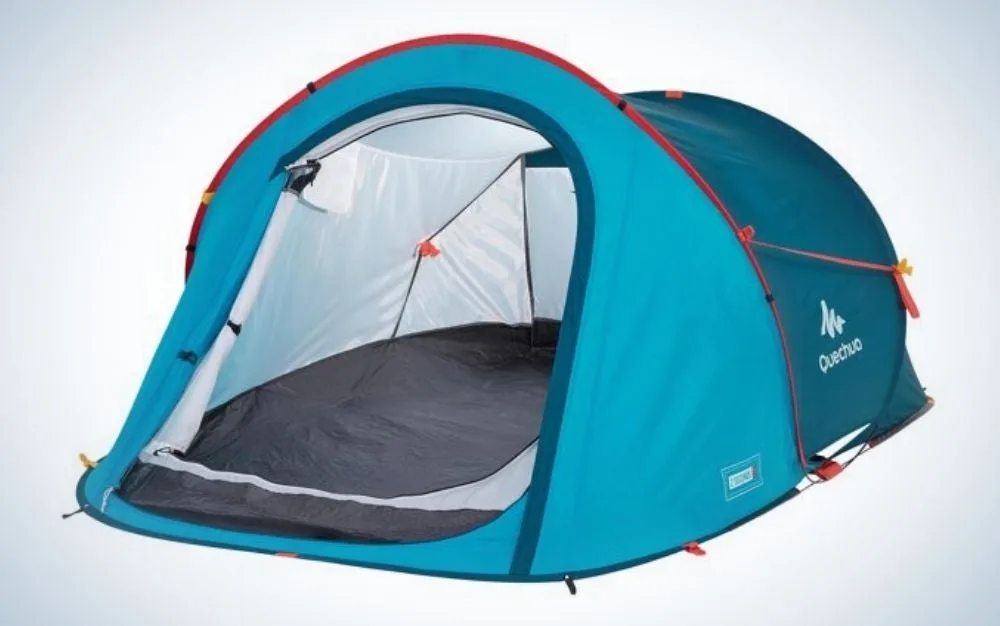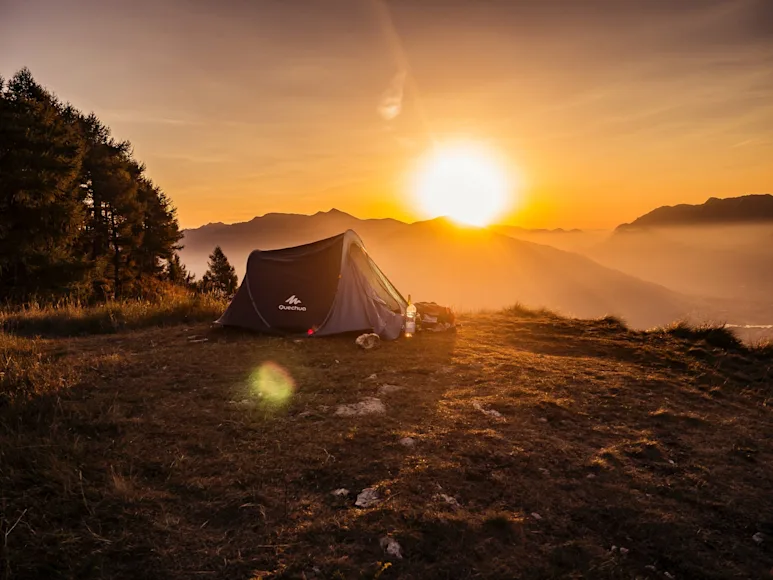_We may earn revenue from the products available on this page and participate in affiliate programs. Learn more ›
_
Best 4 Person

MSR Habitude 4 Family & Group Camping Tent
LEARN MORE
Summary
This strong and reliable family tent is tall enough to stand up in and has a full-coverage rainfly for three-season camping.
Best 6 Person

Big Agnes Spicer Peak 6
LEARN MORE
Summary
Roomy, full-coverage rainfly, and double vestibule makes this the dream tent for your big group.
Best Budget

Coleman Skydome Tent
LEARN MORE
Summary
Affordable, reliable, and super-fast assembly makes this the best budget tent for family camping.
The best family camping tent is one that you can enjoy as your family grows. The tent should not only be big enough, but it needs to be a durable design with enough features to keep everyone comfortable and happy. Choose a tent that offers all the right things to ensure everyone will have a positive experience in the outdoors.
Like any piece of outdoor gear, choosing a quality tent
often comes down to personal preference and meeting your family’s specific needs. Before jumping down to our top picks, read through our buyer’s guide. There you’ll discover the things you need to know to find the best family camping tent for you.
Best 4 Person: MSR Habitude 4 Family & Group Camping Tent
Best 6 Person: Big Agnes Spicer Peak 6
Best Ultralight: Kelty Grand Mesa 4 Person Tent
Best Budget: Coleman Skydome Tent
Best for Cold Weather: OneTigris Iron Wall Stove Tent
Best Pop Up: Decathlon’s Quechua 2 Second XL Waterproof Camping Tent
Best Waterproof: Marmot Halo 4
How We Picked the Best Family Camping Tents
I started taking my kids camping when they were three months old. Now at age three and five, I also take them backpacking. My time camping with my family has helped discover the things to consider when finding the perfect family camping tent.
But my experience with family tent camping goes back even before I had a family of my own. As a wilderness instructor for the Appalachian Mountain Club, I routinely led intro-to-camping and intro-to-backpacking programs for children and teens. Spending multiple seasons teaching basic camping with kids helped narrow down the good, bad, and the ugly when it comes to big tents for camping.
When looking for the best family camping tents for this piece, I evaluated products using the following two criteria:
Quality: It’s important to have a tent that will last. Camping with multiple people, kids, gear, and maybe even a dog can put wear and tear on the tent. Zippers, tent floor, and poles can take a beating on the family camp trip. I chose large tents that are high quality and should last many years. Most of the included tents also come with warranties.
Comfort: Everyone is going to have a better time on the family camping trip if they are dry and comfortable. Features like tall standing height, large doors, full coverage rainfly, lights, and storage vestibules might not be necessary for a solo camper, but it makes a big difference when camping with kids.
If you’d like to see another of our team’s recommendations, check out these picks for best tents
for camping, backpacking, and more
.
Best Family Camping Tents: Reviews & Recommendations
Best 4 Person: MSR Habitude 4 Family & Group Camping Tent
Best 4 Person Tent

MSR Habitude 4 Family & Group Camping Tent MSR
Specs
Three-season
Weight: 12 pounds, 10 ounces
Set up dimensions: 95 x 95 x 73 inches
Packed dimensions: 23 x 9 inches
Pros
Full coverage rainfly
Standing height
Lightweight
Cons
Expensive
If you are going out camping with the family, you want a durable tent that will hold up in the weather. The full coverage rainfly of the Habitude checks the first box for an all-weather family tent. The next big win for this tent is that with over six feet of height clearance, most adults can easily stand up inside. This is useful for getting dressed, setting up, and maneuvering.
This tent is relatively easy to set up with three aluminum 7000 series poles that are both lightweight and durable. The floor has 62 square feet of surface area, which is plenty of room for four sleepers. In addition, there’s an additional 23.5 square foot vestibule under the fly for storage out of the rain. Want more room? This tent also comes in a six-person version
. Another fun extra is that this tent comes with a porch light for nighttime easy entry.
With the high clearance, quality materials, and impressive rainfly, this is the best family camping tent for a family of four. The only setback to this product is the high cost. If you are planning on frequent camping, it’s worth the investment. But if you’re looking for something more budget friendly, consider the Coleman Skydome
. Although, with a three-year manufacturing warranty, you can have some peace of mind that your tent will make it through a few seasons.
Best 6 Person: Big Agnes Spicer Peak 6
Best 6 Person Tent

Big Agnes Spicer Peak 6 Spicer Peak
Specs
3-Season
Weight: 15 pounds, 4 ounces
Set up dimensions: 100 x 118 x 80 inches (not including vestibule)
Packed dimensions: 11.5 x 26 inches
Pros
Full coverage rainfly
Standing height
Two doors and two vestibules
Cons
Expensive
The Spicer Peak is a new tent from Big Agnes, introduced in 2023. It is similar to the company’s Big House 6, but offers better weather resistance. It was exciting to test out this reliable, durable, and comfortable family-sized shelter.
Just by the look of it, it’s easy to see that Big Agnes’s Spicer Peak 6 has some advantages. The full coverage fly will protect all inhabitants from rain while the double doors on either side provide great airflow when the fly is open. Along with the two large doors, double vestibules totaling 15 square feet give impressive storage for the supplies you need to keep out of the weather. And with an 80-inch clearance, this tent was plenty tall enough for most inhabitants to easily maneuver.
Despite the size, it was overall easy to set up this tent with color-coded webbing and buckles. The tent is big and roomy—so it’s great for a basecamp but too big and heavy to bring backpacking
. This tent holds up against the rain with waterproof nylon and seams sealed with polyurethane tape. A footprint/ground tarp is sold separately and will elongate the life of the bottom of the tent.
Best Ultralight: Kelty Grand Mesa 4-Person Tent
Best Ultralight Tent

Kelty Grand Mesa 4-Person Tent Kelty
Specs
Three-season
Weight: 7 pounds, 4 ounces
Set up dimensions: 98 x 80 x 56 inches
Packed dimensions: 18 x 7.5 x 7.5 inches
Pros
Full coverage rainfly
Lightweight
Durable
Cons
Low height clearance
For those looking for a durable, lightweight tent for a family backpack, this tent is for you. The Kelty Grand Mesa comes in a 4-person and 2-person model. I tested the 4-person. My favorite features of this tent were the easy set up and full coverage rainfly.
Although there are lighter four-person backpacking tents out there, the Grand Mesa is durable and reliable against wind and rain. To reduce weight, the tent is low clearance. But with only 56 inches of interior height, an adult cannot stand to dress or maneuver. Still, this could definitely work as a lightweight family camping tent if you don’t mind some gymnastics when getting dressed.
Another benefit of the Grand Mesa is affordability. It sells for just under $200 which means it costs less than most of its competitors without sacrificing quality. As a backpacking guide, I relied on Kelty backpacking tents season after season and was continually impressed with their weatherproofing and longevity especially alongside some of the pricier competitors. The Kelty Grand Mesa also does not come with an included footprint/ground tarp.
Best Budget: Coleman Skydome Tent
Best Budget Tent

Coleman Skydome Tent Coleman
Specs
Three-season
Weight: Unavailable
Set up dimensions: 96 x 84 x 56 inches
Packed dimensions: Unavailable
Pros
Easy, quick set up
Affordable
Durable
Cons
No storage vestibule
Partial coverage rainfly
If you are looking for a reliable family tent that won’t break the bank, the Coleman Skydome is a safe bet. The Coleman Skydome tried and true design comes in every size: two-person, four-person, six-person, or eight-person.
With a price a fifth of some of its competitors, you might assume the Coleman has nothing new to offer. You’d be wrong. No footprint is needed with the durable and waterproof tent floor made from Coleman’s WeatherTec™ system. I also appreciate the wide door that’s great for both ventilation and moving in an air mattress or cot.
The 4-foot height clearance means most campers will not be able to fully stand in the tent. This can be tough for families trying to maneuver and get dressed.
While the tent itself fairs well against moisture, the lack of a full-coverage rainfly makes this tent a poor choice for heavy rain and wind. If your excursion calls for likelihood of storms, invest in the Skydome model with full fly vestibule
. With this model, you’ll be protected against inclement weather as well as provided with storage for your gear. Coleman tents also come with a one-year warranty.
Best for Cold Weather: OneTigris Iron Wall Stove Tent
Best Cold Weather Tent

OneTigris Iron Wall Stove Tent OneTigris
Specs
Four-season
Weight: 4 pounds, 3 ounces (not including stove)
Set up dimensions: 126 x 126 x 62 inches
Packed dimensions: 17.7 x 5.5 x 5.5 inches
Pros
Warm and durable against snow
Affordable
Lightweight
Cons
Stove sold separately
Small
If you are planning on family camping in snow and cold temperatures
, consider getting a hot tent. These tents are made with a chimney hole to accommodate small wood stoves. The OneTigris Iron Wall Stove is an affordable and reliable shelter in extreme cold which makes it the best cold weather tent.
This tent is a heptagon/teepee shape. For a cold weather tent, it’s very light and fairly easy to set up. It comes with a single tent pole that supports the center and rises to just over five feet. The material is a waterproof nylon that is both light and resistant to weather.
While many teepee-style hot tents do not have an inner liner, this one comes with a mesh inner tent that will protect inhabitants from insects and small animal intruders. Be aware that while the outer tent has a 10 x 10 foot footprint, the inner mesh tent is only 9 x 2.6 feet, making it a significantly smaller area for families.
Lastly, the major benefit of this tent is that it accommodates a stove. This tent does not come with the tent stove nor the flashing that allows the chimney to extend through the roof of the tent. While this is perfect for a couple people to camp out in winter, if you’re camping with a bigger bunch, spring for the larger version called the OneTigris Rock Fortress
.
Best Pop Up: Decathlon’s Quechua 2 Second XL Waterproof Camping Tent
Best Pop Up

Decathlon’s Quechua 2 Second XL Waterproof Camping Tent Decathlon
Specs
Three-season
Weight: 11 pounds, 11 ounces
Set up dimensions: 82.6 x 82.6 x 42.9 inches
Packed dimensions: 35-inch disk
Pros
Easy, quick set up
Affordable
Waterproof
Cons
Poor ventilation
The set up on this pop-up tent is incredibly impressive. True to its claim, with a simple toss, this tent opens in a mere second. While it is completely free-standing without stakes, it’s a good idea to take a minute to stake it down and prevent it from tumbling away in the wind. The simplicity, durability, and affordability of this tent makes Decathlon’s Quechua 2 Second XL Waterproof the best pop-up tent.
This is the perfect tent if you are going to need to set up a tent quickly in the rain. In a near instant, you have a waterproof shelter rated for extreme wet. There is no additional ground tarp or rain fly required and the tent free stands in winds up to 30 mph.
Packing up the tent is not intuitive, so my recommendation is to practice multiple times before taking it out into the wilderness. Once you get the hang of it, pack up is quick. While it’s called the “XL”, the tent can only accommodate three adults, so it’s best for small families and couples. If you are looking for a quick set up tent for up to six people, go with the Coleman 6-person Instant Tent
.
The biggest con of this tent is ventilation and darkness. With no windows and a black interior, this is not a tent to hang out in all day. However, it’s a great evening shelter to put up on the fly. The Quechua tents also come with a three-year warranty.
Best Waterproof: Marmot Halo 4
Best Waterproof

Marmot Halo 4 MARMOT
Specs
Three-season
Weight: 14 pounds
Set up dimensions: 96 x 96 x 59 inches
Packed dimensions: 24 x 8 x 7 inches
Pros
Easy, quick set up
Waterproof
Good ventilation
Cons
Expensive
Low height clearance
The Marmot Halo might look like a simple family camping tent, but don’t be fooled—this tent was made for bad weather. Like the Decathlon Quechua, the dome shape helps brace against high wind while the full coverage tent fly made of 68D polyester ripstop prevents rain from entering. Make sure you open the fly vents even when rainy—this prevents condensation forming on the inside.
Have to set up in the rain? Not a big deal. While not as fast as the 2 Second Quechua, with a little practice, it takes about five minutes to set this tent up including the fly and stakes.
Users will be impressed by the quality and durability of the Marmot Halo 4. From the tape-sealed seams to strong aluminum poles, this tent will last the test of time and weather. I recommend the purchase of the footprint/ground cover that is sold separately to lengthen the life of the floor.
This tent is also a comfortable four-person tent, complete with a large double door. However, with the height just under five feet, you can’t stand up in it like the MSR Habitude.
While it’s perfect for family camping trips in rough weather, it’s not very affordable. If you want a durable tent but don’t expect to be seeing much rain, opt for the best budget tent option.
What to Consider When Choosing a Family Camping Tent
When shopping for the best family camping tent
, it’s important to keep a few things in mind. First, consider how many people you want to comfortably sleep in the tent. Next, what type of weather does it need to withstand? Finally, are there special features you’ll want for the best family camping experience? Here’s a breakdown of what to look for.
Size
Family camping tents come in many sizes and shapes. From a two-person ultralight backpacking tent to an eight-person cabin, there are multiple size measurements you should be aware of.
Number of People: Tents are usually categorized by the number of people who can sleep side by side on the floor. For example, a standard four-person tent can fit four adults lying side by side, wall to wall. So, if you are planning on bringing a large air mattress or cot, check the square footage of the floor or choose a larger model. Be aware that backpacking tents usually scale their “person” even smaller so that a two-person tent would only comfortably fit one person…and maybe their dog.
Standing Height: Tent manufacturers give the standing height of the tent in their tent specifications. A tent height over six feet like the Big Agnes Spicer Peak and MSR Habitude allows most people to comfortably change clothing without lying down. If families are traveling with small kids, it’s important to make sure your travel cribs and cots can clear the ceiling. Most backpacking and ultralight tents sacrifice height to keep the weight down.
Packed Size and Weight: Another consideration is how big and heavy it is when it’s all packed up. Large family tents often pack down to the size of a large duffel bag and can be 15 pounds or more. Ultralight backpacking tents weigh just a few pounds and pack smaller than a sleeping bag. Think about your need to save space and weight versus overall room and comfort.
Weather
Are you fair weather campers or ready to take this tent into rain, snow, and wind? Not all tents are equal when it comes to weather resistance. Here’s what you need to know.
Season: Tents are categorized and three-season or four-season. As the name suggests, three-season tents are not made for winter. They value breathability and are often lightweight compared to their four-season counterparts. Most tents are three-season. Winter, or four-season tents, are built to withstand higher winds, snow, and heavy rain. They are more durable but often have poor ventilation which makes them less comfortable for warm-weather camping. If you’re looking specifically for a winter tent, check out our picks for best winter tents for a rundown.
Rainfly: Most three-season family camping tents come with a screen roof that you then assemble an additional rainfly on top. The fly shades the tent, protects it from rain, and keeps in heat. If you plan on camping in rainy locations, spring for a full coverage fly. Tents like the MSR Habitude, Big Agnes Spicer Peak, and Kelty Grand Mesa have a rainfly that covers the entire tent and draws water away from the tent with staked guylines. Tents with a full coverage rainfly are usually more expensive, so if you’re sticking to sunny skies, the more budget friendly Coleman Skydome
will meet your needs.
Features
Family camping tents come with all sorts of features. Here’s some to look for:
Vestibule: The vestibule is a covered porch outside your tent for your muddy shoes, bags, gear, etc. Not all tents come with this feature, but it can be really useful—especially in inclement weather camping.
Storage: Many family camping tents have interior pockets to store those items you’ll need on the fly.
Footprint: A tent’s floor should be waterproof and resistant to moisture; however, you can add an extra moisture barrier and protect the bottom by purchasing a footprint. This ground tarp is made specific to the tent and is usually sold separately by the manufacturer.
Lights: Tents like the MSR Habitude come with LED porch lights. Others have hooks to hold lanterns.
Doors and Windows: It’s important to consider the openings on your tent. A large door and big windows provide better ventilation for hot summer camping. Large doors are also useful if you plan to insert a cot or inflatable bed.
Quick Set Up: Some families will prioritize a quick set up. Look for an “instant” or “pop up tent” like the recommendations below.
Ultralight: For family backpacking, emphasis should be put on the pack weight of the tent. Ultralight tents are a must if you plan to carry it into the wilderness.
Do You Need to Own a Tent?
If you’re reading this article, chances are you are in the market to buy a family camping tent.
What if we told you that there is a more sustainable and budget-friendly option?
Well, there is: renting.
There are several outfitters and companies that have some of the best family camping tents and brands available to rent. Within those, some programs might even offer rent-to-buy options. If you have a local outfitter, ask if they sell any of their old gear. Many outfitters eventually upgrade their rentable items and sell the old ones at a much more affordable rate.
Why would you rent a tent, though?
There are several reasons to rent a tent:
Save Money: renting is often much cheaper than buying new. If you are renting every week, this isn’t as affordable, but renting is a more budget-friendly alternative if you are new to camping and want to try it out.
Test More Tents: when you are in the market for buying new gear, like a tent, it can be hard to choose. Renting allows you to test out some of the tent models you are interested in buying. Then, when you eventually buy a tent, you know you’ve made a quality choice.
You Don’t Camp Often: if you are a family that only camps once or twice a year, you might not need a tent of your own. Renting allows you to have a couple of family camping trips a year without the investment of purchasing your gear all at once.
Travel: When you travel to another state or even another country as a family, packing all of your gear can become overwhelming and expensive. Renting once you get to your destination cuts out a big part of the planning and often saves you money in the long run.
Buying a new tent isn’t required to go camping. You have options like renting, or better yet, ask your friends and family. Many people in our lives have some gear they are willing to lend out. That way, you can get a feel for the activity and the equipment before investing. If neither of those is available to you, check out used gear options like local outfitters, gear consignment stores, and even online retailers.
FAQs
Q: Is it worth buying an expensive tent?
It is worth buying an expensive tent if you need the components it provides. Features like ultralight pack weight, storage vestibule, full coverage rainfly, or large size come with a price. If these are useful to you and it will make your family camping experience more comfortable, then it’s worth it.
Q: How big of a tent do I need for a family of 4?
A 4-person tent will accommodate four people sleeping side by side on the ground. Therefore, if you want to add in large air mattresses, cots, luggage, and maybe even a dog, consider sizing up if you have the budget and room. I personally use a six-person tent for my family of four.
Q: Do tents lose their waterproofing?
Nylon and polyester tents lose their waterproofing over time. Tent waterproofing is usually measured in mmH2O and refers to the weight of the water that can push on the material before it goes through. The higher numbers are more waterproof with most rainfly ratings 1,000 mm or more. The waterproofing comes from the tightness of the fabric weave as well as a treatment of Durable Water Repellent (DWR). This DWR will break down over time and the tent will become less waterproof. Tent owners can purchase treatments
to re-waterproof their tents. Always check with the manufacturer suggestions before adding a treatment to your gear.
Q: Should a family camping tent have separate rooms?
Having a family tent with rooms is ideal if you want some additional privacy, but it isn’t required. Many families find the extra rooms highly functional and worthwhile, especially if they are camping with a larger group.
Q: Is it easy to set up a family camping tent?
How easy a big tent for camping is to set up depends on the type of tent and overall construction. Freestanding tents tend to be among the easiest and most straightforward to set up. Large camping tents are easiest to set up when several people can help.
Best Family Camping Tents: Final Thoughts
Finding the best family camping tent can be a daunting task, but worth it when you are all comfortable, warm, and have a good night’s sleep. Build memories with your family in the outdoors by finding the best family camping tent for you and spending as many nights in it together as possible.
Why Trust Us
For more than 125 years, Field & Stream has been providing readers with honest and authentic coverage of outdoor gear. Our writers and editors eat, sleep, and breathe the outdoors, and that passion comes through in our product reviews. You can count on F&S to keep you up to date on the best new gear. And when we write about a product—whether it’s a bass lure or a backpack—we cover the good and the bad, so you know exactly what to expect before you decide to make a purchase.






